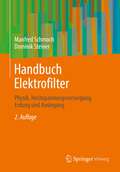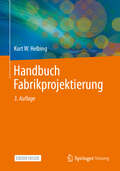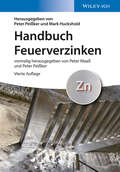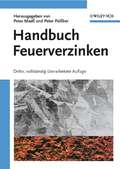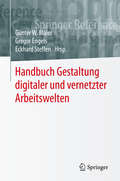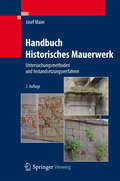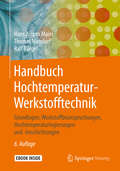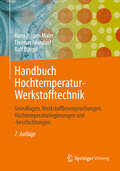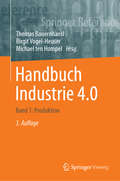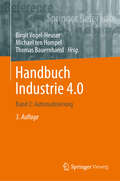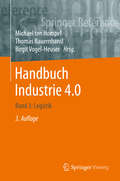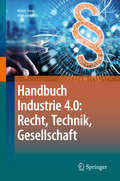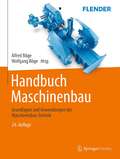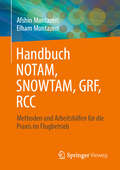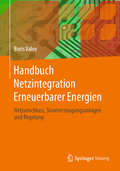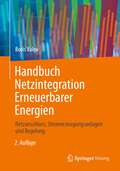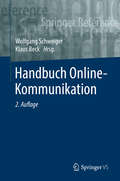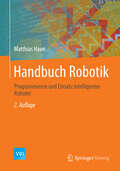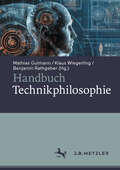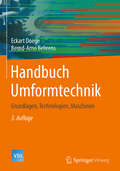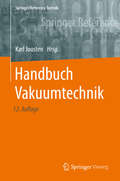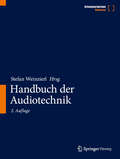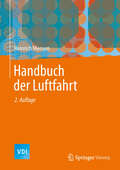- Table View
- List View
Handbuch Elektrofilter: Physik, Hochspannungsversorgung, Erdung und Auslegung
by Manfred Schmoch Dominik SteinerDer Leser erhält Informationen zu Anlagen der elektrischen Gasreinigung, wie sie in Kraftwerken, Stahlwerken, Zementwerken, Chemieanlagen, KWK-Anlagen und Biomassekraftwerken betrieben werden.Elektrostatische Abgasfilter stellen hohe Anforderungen an eine sorgfältige und vollständige Erdung. Dabei prallen die teilweise gegensätzlichen Anforderungen der Schutzerde, der Funktionserde und der EMV-Erde aufeinander, die nicht zuletzt durch Normen und Vorschriften festgelegt sind. Das Buch bietet Hintergrundinformationen zu den verschiedenen Erdungsarten sowohl auf technischer als auch auf rechtlicher Ebene. Aus den Anforderungen und Hintergrundinformationen werden die Lösungen für hochwertige Erdungen im Elektrostatischen Abgasfilter abgeleitet, die insgesamt dazu führen, dass das Elektrofilter effizienter arbeitet.
Handbuch Fabrikprojektierung
by Kurt W. HelbingDieses umfassende und systematisch aufgebaute Handbuch befasst sich mit der ganzheitlichen Projektierung der Produktion in Fabriken. Es behandelt sowohl die Systeme der Produktion für die Teilefertigung und Erzeugnismontage, der Ver- und Entsorgung sowie des Fabrikbetriebes als auch die Erhaltungs- und Materialflusssysteme.Ausgehend vom Produktionsprogramm beschreiben die Autoren, wie die Systeme der Fabrik unter Beachtung praktischer Aspekte durch Funktionsbestimmung, Dimensionierung und Strukturierung entwickelt, optimiert und realisierungsgerecht gestaltet werden. In den Projektierungsmethoden kommen Prinzipien, Grundsätze, Berechnungsvorschriften und Algorithmen zur Anwendung. Dabei steht die Technologische Projektierung im Vordergrund, deren einzelne Phasen, Stufen und Schritte für alle Systeme der Fabrik exakt und reproduzierbar abgearbeitet und durch Beispiele unterstützt werden.Neu in der 3. Auflage (noch zu ergänzen)Die ZielgruppenDieses Buch wendet sich an Technologische Projektanten, Fabrikplaner, Architekten, Investitionsbewerter, Technologen, Werkplaner u.ä. Berufsgruppen, die in der Forschung, in der Lehre oder in der Praxis tätig sind. Angesprochen sind auch Studenten der betreffenden Studien- und Vertiefungsrichtungen.
Handbuch Feuerverzinken
by Peter Peißker Mark HucksholdIn der nunmehr vierten Auflage ist das ?Handbuch Feuerverzinken? konzeptionell und inhaltlich vollständig überarbeitet und aktualisiert worden. Inzwischen nicht mehr anwendungsrelevante Themen wurden gestrichen, während neue rund um den aktuellen Stand der Technik hinzugekommen sind. Dabei wird das Feuerverzinken als ein geschlossenes System beschrieben und alle industrierelevante Teilgebiete beleuchtet, wie zum Beispiel: wirtschaftliche und anwenderspezifische Aspekte, die Oberflächenvorbereitung, das Korrosionsverhalten von Zinküberzügen, Duplex-Systeme bis hin zum Umweltschutz und der Arbeitssicherheit. Dabei wird der Inhalt durch ein Wechselspiel zwischen theoretischen Grundlagen und Beispielen aus der Praxis vermittelt; zahlreiche Bilder, Skizzen und Tabellen unterstützen das Verständnis. Abgerundet wird das Gesamtkonzept mit Erläuterungen zur Qualitätssicherung mit den dazugehörigen DIN- und ISO-Normen und aktualisierten Tabellen, die alle relevanten Daten zum Feuerverzinken abdecken. Das Buch schafft es, in verständlicher und praxisnaher Weise das A und O des Feuerverzinkens zu erklären. Perfekt geeignet als Lehrbuch für Berufseinsteiger sowie als Nachschlagewerk für Praktiker in Betrieben, die sich mit allen Aspekten des Feuerverzinkens befassen.
Handbuch Feuerverzinken
by Peter Maaß Peter PeißkerViele moderne Geb ude und Konstruktionen wie Bahnh fe, Hotelatrien, Brucken und Kuppeln ben tigen ein Stahlskelett, das auf Jahrzehnte gegen sch dliche Einwirkungen gesch tzt ist. Feuerverzinkung ist hierfur eine ausgereifte und bew hrte Methode, deren Schutz berzug aus Zink zuverl ssig Stahlteile auf Jahrzehnte gegen sch dliche Einwirkungen sch tzt. Das Buch deckt systematisch alle Schritte des Feuerverzinkungsprozesses ab und geht dabei nicht nur auf die Verfahrenstechnik ein, sondern auch auf die wichtigen Aspekte der feuerverzinkungsgerechten Konstruktion, Arbeitssicherheit, Umweltschutz, Duplex-Systeme und Wirtschaftlichkeitsbetrachtungen. Das Buch ist reich und in Farbe bebildert und zeigt zahlreiche Anwendungsbeispiele.
Handbuch Gestaltung digitaler und vernetzter Arbeitswelten (Springer Reference Psychologie Ser.)
by Gregor Engels Günter W. Maier Eckhard SteffenDieses interdisziplinäre Handbuch richtet sich an all diejenigen, die den digitalen Wandel, der im Zusammenhang mit der vierten industriellen Revolution (Industrie 4.0) diskutiert wird, in Betrieben, Verwaltungen und der Gesellschaft besser verstehen und aktiv gestalten möchten. Die einzelnen Beiträge veranschaulichen die vielfältigen Perspektiven unterschiedlicher Disziplinen (z.B. Ingenieur-, Rechts- und Wirtschaftswissenschaften, Informatik, Psychologie, Soziologie, Erziehungswissenschaft u.a.) oder Interessensgruppen (z.B. Gewerkschaften) auf die Folgen der Digitalisierung im Arbeitsleben für Mensch, Organisation und Gesellschaft. Das gesamte Werk schlägt eine Brücke von aktuellen Forschungsergebnissen hin zu praktischen Umsetzungshinweisen. Im Zentrum stehen drei zentrale Fragen zur Digitalisierung des Arbeitslebens, und zwar woran man sich bei der Gestaltung orientieren, wie die Transformation gestaltet werden und worauf sich die Digitalisierung auswirken kann. Beispielthemen dieser 3 Bereiche: 1. Im Zusammenhang mit den Gestaltungskriterien: sichere und gesundheitsförderliche Gestaltung der digitalen Arbeitsweltarbeitsrechtliche Aspektepsychologische Arbeitsgestaltung digitaler Arbeitswelten 2. Im Zusammenhang mit der Art und Weise des Wandels von analogen zu digitalen Arbeitswelten: Chancen für gesundheitsorientierte Arbeitsgestaltung durch körpernahe und tragbare Sensorik neue Aufgabenverteilung durch kollaborative Roboter im Rahmen der Mitbestimmung Prozesse durch proaktive betriebliche Interessensvertretung gestalten 3. Im Zusammenhang mit den Konsequenzen: Auswirkungen digitaler Arbeitswelten auf die Beschäftigungsstrukturen und das Privatleben Möglichkeiten dieser Entwicklung für die Inklusion älterer Menschen oder Menschen mit Behinderung ZielgruppenAnwender/innen und Entwickler/innen digitaler Technologien, Führungskräfte, Personalleiter/innen und Entscheidungsträger/innen in Unternehmen, Verbänden und der Politik
Handbuch Historisches Mauerwerk
by Josef MaierDas Buch bietet einen umfassenden Überblick zu Schäden am historischen Mauerwerk: nicht nur Feuchtigkeits- und Salzschäden, sondern auch Schäden durch Risse und lose Füllschichten. Der Autor liefert wertvolle Tipps zur Erkennung der Schadensursachen sowie Anleitungen für zerstörungsarme Untersuchungen und für die Instandsetzung. In die 2. Auflage wurden neue technische Möglichkeiten zur Instandsetzung von historischem Mauerwerk aufgenommen, aktuelle Normen und Regelwerke sowie neue Anforderungen zum Schall- und Wärmeschutz wurden berücksichtigt.
Handbuch Hochtemperatur-Werkstofftechnik: Grundlagen, Werkstoffbeanspruchungen, Hochtemperaturlegierungen und -beschichtungen
by Hans Jürgen Maier Thomas Niendorf Ralf BürgelDieses Handbuch zeigt umfassend und systematisch die metallkundlichen Vorgänge oberhalb etwa 40 % der absoluten Schmelztemperatur. Auch werden in diesem Standardwerk Hochtemperaturlegierungen über 500 °C und deren Beanspruchungen in Bauteilen praxisnah dargestellt. Das Buch dient als zuverlässiger Ratgeber in Studium und Beruf. In der aktuellen Auflage wurde die Additive Fertigung neu aufgenommen sowie der Abschnitt über Rekonditionierungsmaßnahmen (MRO) gezielt ergänzt.
Handbuch Hochtemperatur-Werkstofftechnik: Grundlagen, Werkstoffbeanspruchungen, Hochtemperaturlegierungen und -beschichtungen
by Hans Jürgen Maier Thomas Niendorf Ralf BürgelDieses Handbuch zeigt umfassend und systematisch die metallkundlichen Vorgänge oberhalb etwa 40 % der absoluten Schmelztemperatur. In diesem Standardwerk werden vor allem Hochtemperaturlegierungen für Einsatztemperaturen über 500 °C und deren Beanspruchungen in Bauteilen praxisnah dargestellt. Die vorliegende Auflage wurde überarbeitet und das Kapitel zur Additiven Fertigung um aktuelle Entwicklungen ergänzt. Das Verzeichnis der Werkstoffe wurde aktualisiert. Das Buch hat sich als zuverlässiger Ratgeber in Studium und Beruf bewährt.
Handbuch Industrie 4.0: Band 1: Produktion (Springer Reference Technik Ser.)
by Thomas BauernhanslMit der Neuauflage des erfolgreichen Werkes wird die Geschichte der vierten industriellen Revolution fortgeschrieben und der Dynamik Rechnung getragen, mit der die Vision in den vergangenen zwei bis drei Jahren weiterentwickelt und verwirklicht wurde.Experten aus Wissenschaft und Technik beleuchten verschiedene Facetten der Industrie 4.0 und schaffen gleichermaßen einen Überblick über den Stand der Technik und die Vision selbst. Dies gelingt nicht zuletzt Dank einer ausgewogenen Mischung aus wissenschaftlichen Erkenntnissen, Praxisbeispielen und Übersichtsbeiträgen. Die Themen der Beiträge reichen von Basistechnologien über Integrations- und Migrationsansätze bis hin zu Geschäftsmodellen und Dienstleistungen für die Industrie 4.0. Zudem werden die Datensicherheit und auch rechtliche Aspekte mit Datenanalyse und maschinellem Lernen behandelt. In der dritten Auflage werden die Themenfelder um Künstliche Intelligenz, aktuelle Mobilfunkstandards und den daraus resultierenden Potentialen für eine zukünftige Plattformökonomie erweitert.Die dritte überarbeitete und erweiterte Auflage erscheint wiederum in 3 Bänden. Der vorliegende erste Band wurde von Thomas Bauernhansl und Andreas Bildstein konzeptioniert und umfasst neue und bearbeitete Beiträge zur Produktion. Online ist dieses Nachschlagewerk auch über Springer Reference verfügbar.
Handbuch Industrie 4.0: Band 2: Automatisierung
by Michael Ten Hompel Birgit Vogel-Heuser Thomas BauernhanslMit der Neuauflage des erfolgreichen Werkes wird die Geschichte der vierten industriellen Revolution fortgeschrieben und der Dynamik Rechnung getragen, mit der die Vision in den vergangenen zwei bis drei Jahren weiterentwickelt und verwirklicht wurde.Experten aus Wissenschaft und Technik beleuchten verschiedene Facetten der Industrie 4.0 sowohl aus akademischer als auch aus praktischer Sicht und schaffen gleichermaßen einen Überblick über den Stand der Technik und die Vision selbst. Dies gelingt nicht zuletzt dank einer ausgewogenen Mischung aus wissenschaftlichen Erkenntnissen, Praxisbeispielen und Übersichtsbeiträgen. Die Themen der Beiträge reichen von Basistechnologien (bspw. cyber-physische Systeme) über Integrations- und Migrationsansätze bis hin zu Geschäftsmodellen und Dienstleitungen für die Industrie 4.0. Zudem werden die Datensicherheit und auch rechtliche Aspekte behandelt. In der 3. Auflage werden die Themenfelder um Künstliche Intelligenz, aktuelle Mobilfunkstandards und den daraus resultierenden Potentialen für eine zukünftige Plattformökonomie erweitert. Die dritte Auflage wurde bearbeitet und erweitert, erscheint nun in 3 Bänden. Dieser zweite Band beinhaltet neue und bearbeitet Beiträge zur Automatisierung. Online ist dieses Nachschlagewerk auch über Springer Reference verfügbar.
Handbuch Industrie 4.0: Band 3: Logistik (Springer Reference Technik Ser.)
by Michael Ten Hompel Birgit Vogel-Heuser Thomas BauernhanslMit der Neuauflage des erfolgreichen Werkes wird die Geschichte der vierten industriellen Revolution fortgeschrieben und der Dynamik Rechnung getragen, mit der die Vision in den vergangenen zwei bis drei Jahren weiterentwickelt und verwirklicht wurde.Experten aus Wissenschaft und Technik beleuchten verschiedene Facetten der Industrie 4.0 und schaffen gleichermaßen einen Überblick über den Stand der Technik und die Vision selbst. Dies gelingt nicht zuletzt Dank einer ausgewogenen Mischung aus wissenschaftlichen Erkenntnissen, Praxisbeispielen und Übersichtsbeiträgen. Die Themen der Beiträge reichen von Basistechnologien über Integrations- und Migrationsansätze bis hin zu Geschäftsmodellen und Dienstleistungen für die Industrie 4.0. Zudem werden die Datensicherheit und auch rechtliche Aspekte mit Datenanalyse und maschinellem Lernen behandelt. In der dritten Auflage werden die Themenfelder um Künstliche Intelligenz, aktuelle Mobilfunkstandards und den daraus resultierenden Potentialen für eine zukünftige Plattformökonomie erweitert.Die dritte überarbeitete und erweiterte Auflage erscheint wiederum in 3 Bänden. Der vorliegende dritte Band umfasst neue und bearbeitete Beiträge zur Logistik. Online ist dieses Nachschlagewerk auch über Springer Reference verfügbar.
Handbuch Industrie 4.0: Recht, Technik, Gesellschaft
by Walter FrenzDas Handbuch bietet einen Gesamtüberblick über Industrie 4.0 und gibt zugleich Lösungen für wichtige praktische Fragen. Ausgangspunkt ist dabei das Recht mit seinen aktuellen Herausforderungen Zuordnung der Daten (wem gehören sie? Vorgaben der EU?), Datensicherheit, Datenschutz (Europäische Datenschutzgrundverordnung), Cyberangriffe, Wettbewerbsrecht (Zugangsansprüche gegen Monopolisten, zulässiger und verbotener Informationsaustausch, mögliche Kooperationen). Sodann werden Einzelbereiche von Industrie 4.0 (Internet of Production, Maschinenbau, künstliche Intelligenz, Elektromobilität, autonomes Fahren, Verkehr, Medizin, Bauwesen, Energiewirtschaft etc.) in ihren Besonderheiten beleuchtet. Allgemeine Entwicklungen aus dem Management, der digitalen Transformation der Unternehmen und der Arbeitswelt sowie ethische Fragen schließen sich an.
Handbuch Maschinenbau: Grundlagen und Anwendungen der Maschinenbau-Technik
by Berthold Heinrich Jürgen Bauer Klaus Schreiner Petra Linke Klaus-Dieter Arndt Wolfgang Weißbach Arnfried Kemnitz Peter Kurzweil Dominik Surek Andreas Hirsch Susanna Labisch Gert Böge Werner Bahmann Lutz Barfels Martin Dehli Marcus Kampf Werner Roddeck Johannes Sebulke Frank WeidermannDieses Handbuch vermittelt strukturiert, kompakt und anwendungsorientiert die ganze Welt des Maschinenbaus. Auch in der normenaktualisierten 24. Auflage geben Fachtexte, Formelsammlungen, Einheitentabellen und Berechnungsbeispiele zuverlässige Informationen und erprobte Hilfestellungen für das Studium und für die berufliche Praxis. Die Abschnitte Elektrotechnik und Werkzeugmaschinen wurden komplett überarbeitet und aktualisiert und das Kapitel Verbrennung neu aufgenommen.
Handbuch NOTAM, SNOWTAM, GRF, RCC: Methoden und Arbeitshilfen für die Praxis im Flugbetrieb
by Afshin Montazeri Elham MontazeriDas Buch behandelt das Thema der Veröffentlichung und Erstellung von NOTAM und SNOWTAM sowie des Global Reporting Formats (GRF) aus flugbetrieblicher Perspektive. Primär richtet es sich an Mitarbeitende von Flughäfen, die im Bereich des Flugbetriebs tätig sind (beispielsweise Flugdienstberater) und Flugbesatzungen, deren Aufgabe es ist, diese Informationen zu nutzen, um einen sicheren Flugbetrieb zu gewährleisten. Das Werk enthält eine umfassende Darstellung aller relevanten Informationen, die für Flughafenmitarbeiter von Bedeutung sind, um NOTAM gemäß den Vorgaben der Europäischen Agentur für Flugsicherheit (EASA) und der Internationalen Zivilluftfahrtorganisation (ICAO) zu verfassen und zu veröffentlichen. Desweiteren bietet es einen relevanten Mehrwert für alle anderen Teilnehmer der Luftfahrtindustrie, die NOTAM lesen und verstehen müssen. Dies schließt insbesondere auch Studierende im Bereich Luftverkehrsmanagement mit ein.
Handbuch Netzintegration Erneuerbarer Energien: Netzanschluss, Stromerzeugungsanlagen und Regelung
by Boris ValovIn diesem Werk werden elektrische Netze und Stromerzeugungsanlagen als eine Einheit betrachtet. Dabei wird die Integration Erneuerbarer Energien sowohl in die Netze an Land als auch im Offshore-Bereich behandelt und das nötige Basiswissen dazu vermittelt. Unterschiedliche Generatorsysteme, systemtechnische Anforderungen an die Eigenschaften der Stromerzeugungsanlagen und deren Netzrückwirkungen werden hier beschrieben. Die vorgeschlagenen einfachen Berechnungsverfahren bilden ein hilfreiches Werkzeug zur Planung des Netzanschlusses, zur Konformitätsprüfung mit technischen Netzanschlussregeln, zur Analyse der Auswirkungen auf die bestehenden Netze sowie zur Beurteilung unvermeidbarer Netzrückwirkungen. Die mathematischen Gleichungen und Grafiken sollen eine einfache Beurteilung der Spannungshaltung sowie Spannungsstützung am Netzanschlusspunkt der Stromerzeugungsanlage ermöglichen. Zu den weiteren Inhalten dieses Buches gehören das Glossar zu den wichtigsten, einschlägigen Fachbegriffen, das zwölfsprachige Wörterbuch aus dem Gebiet der Netzintegration sowie der Anhang mit Beispielen für technische Charakteristiken relevanter Netzbetriebsmittel.
Handbuch Netzintegration Erneuerbarer Energien: Netzanschluss, Stromerzeugungsanlagen und Regelung
by Boris ValovIn diesem Werk werden konventionelle elektrische Netze und moderne dezentrale Stromerzeugungsanlagen mit Nutzung Erneuerbarer Energien als eine Einheit betrachtet.Im Mittelpunkt steht die Integration Erneuerbarer Energien in bestehende und neue elektrische Netze an Land und im Offshore-Bereich. Die vorgeschlagenen Berechnungsverfahren, Gleichungen und Grafiken bilden ein hilfreiches Werkzeug zur Planung des Netzanschlusses dezentraler Erzeugungsanlagen mit unterschiedlichen Generatorsystemen und zur Analyse von deren Auswirkungen auf bestehende Netze mit konventionellen Kraftwerken.Zum Buch gehört ein Glossar, ein zwölfsprachiges Wörterbuch und ein Anhang mit technischen Charakteristiken relevanter Netzbetriebsmittel.Für diese Auflage wurden der Text und die Literaturquellen aktualisiert, sowie die Grafiken überarbeitet.
Handbuch Online-Kommunikation
by Klaus Beck Wolfgang SchweigerDas Handbuch gibt in 23 Beiträgen einschlägiger FachautorInnen einen umfassenden und systematischen Überblick des aktuellen Forschungsstandes kommunikationswissenschaftlicher Online-Forschung. Einführend werden die zentralen Fragestellungen, theoretischen Ansätze und empirischen Befunde dargestellt. Das Themenspektrum reicht von den Grundlagen computervermittelter Kommunikation (interpersonale, Gruppen- und öffentliche Kommunikation), über ökonomische, ethische und politische Fragen wie Regulierung und Kontrolle des Internets, sowie seine Verbreitung, Nutzung und Wirkung. Weitere Beiträge befassen sich mit Öffentlichkeit und Journalismus online, kulturellen und sozialpsychologischen Aspekten, Online-Werbung und -PR, Gesundheitskommunikation, E-Learning und Wissensmanagement sowie Online-Spielen. Ein Überblick über Methoden der Online-Forschung sowie die wichtigsten Datenquellen und Standarduntersuchungen rundet das Werk ab.
Handbuch Robotik
by Matthias HaunZiele des Buches ist es, den Roboter als lernendes System aufzufassen, es als wissensbasiertes Modellsystem zu konzeptionalisieren und dieses System durch intelligente, rechnerbasierte Technologien in funktionaler Hinsicht zu implementieren. Das Ziel eines Ansatzes liegt in der Steigerung des systemischen Intelligenzquotienten (sIQ). Erreichbar wird dieses Ziel durch eine Modellierung auf Basis der Kognitionstheorie und der konkreten (Aus) implementierung dieser Modelle durch den Einsatz der Cognitive Computing Technologien unter der Programmiersprache Java.
Handbuch Technikphilosophie
by Mathias Gutmann Klaus Wiegerling Benjamin RathgeberDieses Handbuch behandelt umfassend und systematisch das Phänomen Technik: Einerseits wird der Gegenstand vollständig philosophisch entwickelt, also sowohl ideen- und begriffsgeschichtlich behandelt als auch in die Systematik der philosophischen Probleme eingeordnet. Auf dieser Grundlage kann dann andererseits ein gründliches Gespräch mit anderen Fachgebieten geführt und können die wichtigen Fragen der Technologieentwicklung beantwortet werden.
Handbuch Umformtechnik: Grundlagen, Technologien, Maschinen (VDI-Buch)
by Eckart Doege Bernd-Arno BehrensDas Handbuch Umformtechnik erscheint jetzt in der dritten Auflage. Es ist ein hilfreiches Handwerkszeug für den Umformtechniker und überzeugt durch die kompakte und übersichtliche Darstellung grundlegenden Wissens und komplexer Inhalte für die wissenschaftliche Arbeit und die industrielle Praxis. Aktuelle Forschungsergebnisse sowie Erfahrungen aus über 50 Jahren universitärer Forschung und Lehre machen das Buch zu einem hilfreichen Handwerkszeug für den Umformtechniker. Der InhaltNach einer ausführlichen Darstellung der plastomechanischen und tribologischen Grundlagen widmet sich das Buch der Blechumformung, der Massivumformung sowie den Umformmaschinen in jeweils einem eigenständigen Kapitel. Dabei werden u. a. aktuelle Technologien und Verfahren sowie Pressenantriebe vorgestellt. Zahlreiche Grafiken und Diagramme veranschaulichen die Inhalte. Die ZielgruppenDas Buch wendet sich an Studierende des Maschinenbaus und dient Ingenieuren, Technikern und Wissenschaftlern auf dem Gebiet der Umformtechnik als übersichtliches Nachschlagewerk.
Handbuch Vakuumtechnik: Theorie Und Praxis (Springer Reference Technik)
by Karl JoustenDieses Standardwerk gibt dem Leser umfassend und zuverlässig Informationen zur Theorie und Praxis der Vakuumtechnik. Eine große Anzahl von Beispielen sowie aussagekräftigen Abbildungen erläutern und visualisieren überzeugend die theoretischen Sachverhalte. Die aktuelle Auflage wurde zur besseren Lesbarkeit der gleichzeitigen Onlineveröffentlichung in kürzere Kapitel gefasst und durchgehend überarbeitet und aktualisiert. Im Kapitel zu Turbomolekularpumpen wurde ein neuer Abschnitt zu regenerativen Pumpen eingefügt. Das Kapitel über passive Sorptionspumpen wurde neu geschrieben.
Handbuch der Audiotechnik
by Stefan WeinzierlUmfassendes Nachschlagewerk für das Gebiet der Audiotechnik, verfasst von maßgeblichen Wissenschaftlern und Entwicklern aus Forschung und Industrie. Themen sind akustische und systemtheoretische Grundlagen, Psychoakustik und Audiologie, Räumliches Hören, Hörstörungen und Hörgeräte, Analyse und Synthese von Audiosignalen, Raumakustik, Studioakustik, Mikrofone, Lautsprecher, Kopfhörer, Beschallungstechnik, Aufnahme- und Wiedergabetechniken, Audiobearbeitung, Formate und Übertragungstechnik für Audiosignale und Audio-Messtechnik. Geschrieben für Studierende, Wissenschaftler, Entwickler und Anwender.
Handbuch der Luftfahrt (VDI-Buch)
by Heinrich MensenDas Handbuch der Luftfahrt ist ein praxisorientiertes Nachschlagewerk und Lehrbuch und umfasst alle relevanten Teilgebiete des Luftverkehrs und deren Zusammenwirken. Zunächst werden die betrieblichen Säulen des Luftverkehrs ausführlich erläutert. Dies sind einerseits die Luftverkehrsgesellschaften und die Betreiber von Flugzeugen sowie andererseits die Flugplätze, strukturiert nach Landseite, Terminalbereich und Luftseite. Das Flugzeug selbst wird dabei auf die anstehende Flugaufgabe vorbereitet. Für die sichere, konfliktfreie und wirtschaftliche Durchführung des jeweiligen Fluges ist die Flugsicherungsorganisation verantwortlich, deren betrieblich-technische Aufgaben umfassend erklärt werden. Die Neuauflage des Buches zeigt anhand aktueller Bilder und Beispiele, wie die Transport-, Abfertigungs- und Wegsicherungsprozesse formal und inhaltlich ablaufen, wie diese Prozesse strukturiert und organisiert sind, und mit welchen technischen bzw. infrastrukturellen Instrumentarien sie unterstützt werden. Da diese Prozesse in einem in seiner Kapazität nicht erweiterbaren Luftraum (Verkehrsraum) stattfinden, bedarf es auch einer differenzierten Struktur dieses Luftraumes sowie umfangreicher Regeln und Verfahren zur Nutzung, um den unterschiedlichen Anforderungen gerecht zu werden.
Handbuch der Sportphotographie
by Cristiano Pugno Pia-Felicitas HawleDieses Handbuch richtet sich an all jene, welche sich auf die Sportphotographie spezialisieren wollen. Das Handbuch eignet sich für Anfänger wie auch für fortgeschrittene Photographen, die Empfehlungen eines erfahrenen Kollegen wertschätzen, Photographen, die für sich selbst oder aber auch für Magazine, Tageszeitungen oder Photoagenturen tätig sind. Das Buch gliedert sich in drei Teile und diskutiert die verschiedensten Sportarten, beim Fußball angefangen, über den Laufsport, Hallensportarten und schließlich die Wassersportarten.
Handbuch der Sportphotographie
by Cristiano Pugno Pia-Felicitas HawleDieses Handbuch richtet sich an all jene, welche sich auf die Sportphotographie spezialisieren wollen. Das Handbuch eignet sich für Anfänger wie auch für fortgeschrittene Photographen, die Empfehlungen eines erfahrenen Kollegen wertschätzen, Photographen, die für sich selbst oder aber auch für Magazine, Tageszeitungen oder Photoagenturen tätig sind. Das Buch gliedert sich in drei Teile und diskutiert die verschiedensten Sportarten, beim Fußball angefangen, über den Laufsport, Hallensportarten und schließlich die Wassersportarten.
